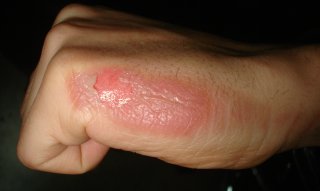2nd degree burns - skin is wrinkled, lots of colour or no colour. no hard edges
3rd degree burns - no hard edges. stipple colour on lots of little colours. acid, fire, dark black colours and soot
think about ages of burns, is it infected
Burns are among the most common household injuries especially in children. Burns are categorised by severe skin damage in which many are infected. Most people can recover from burns without serious health consequences.
BURN LEVELS
The degree of the burns are dependent on how severe they are. Damage includes:
- First Degree Burns: red, non-blistered skin
- Second Degree Burns: blistered and some thickening of the skin
- Third Degree Burns: widespread thickness with a white leathery appearance.
There is technically also fourth degree burns which is where the burn extends beyond the skin into tendons and bones.
MOST COMMON CAUSES OF BURNS
- Scalding from hot, boiling water
- Chemical burns
- Electrical burns
- Fires, including flames from matches, candles and lighters
- Excessive sun exposure
FIRST DEGREE BURNS
- Minimal skin damage
- redness
- minor inflammation
- pain
- dry, peeling skin
- usually can be treated at home
- affects the top layer of skin

SECOND DEGREE BURNS
- extends beyond the top layer of skin
- blisters
- red and sore
- wet appearance

THIRD DEGREE BURNS
- Damage extends through every layer of skin
- Can reach bloodstream, major organs and bones which could lead to death
- With this degree you may not feel pain because your nerves are damaged
- the skin can look waxy
- charred
- dark brown
- raised and leathery
- carry the most risk for complications

No comments:
Post a Comment